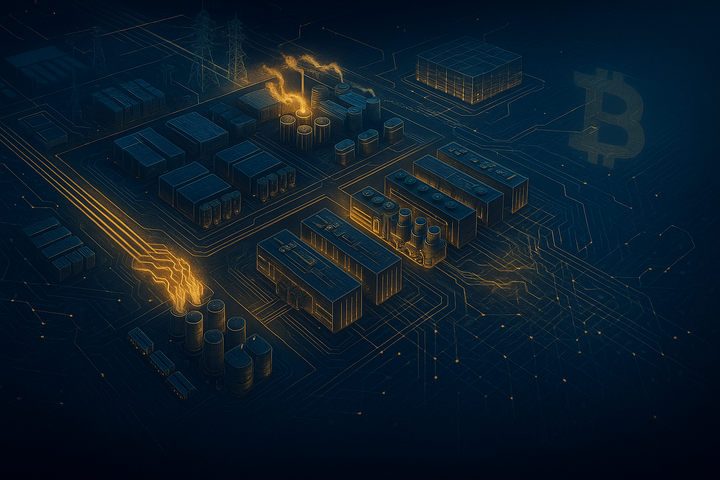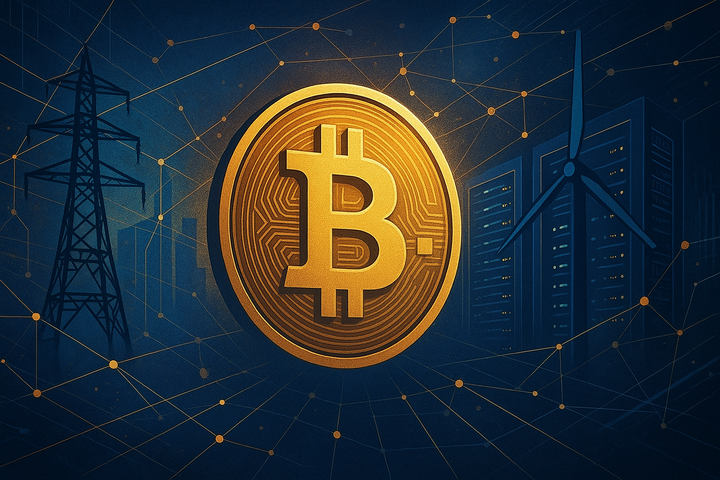AI Buildout, Power Bottlenecks, and Bitcoin Optionality
The September 21, 2025 episode of the Jordi Visser Podcast features Jordi outlining how an AI-led capex cycle is colliding with power constraints, long equipment lead times, and memory tightness as inference shifts toward on-device NPUs.

- My 'briefing notes' summarize the content of podcast episodes; they do not reflect my own views.
- They contain (1) a summary of podcast content, (2) potential information gaps, and (3) some speculative views on wider Bitcoin implications.
- Pay attention to broadcast dates (I often summarize older episodes)
- Some episodes I summarize may be sponsored: don't trust, verify, if the information you are looking for is to be used for decision-making.
Summary
The September 21, 2025 episode of the Jordi Visser Podcast features Jordi outlining why markets endorse rate cuts while headline inflation remains sensitive to gasoline. Visser argues that an AI-led capex cycle is colliding with power constraints, long equipment lead times, and memory tightness as inference shifts toward on-device NPUs. He notes Bitcoin remains structurally supported by very low institutional allocation, preserving asymmetric upside if macro conditions hold.
Take-Home Messages
- Policy Backdrop: Tight credit spreads and calmer bonds indicate cuts are consistent with risk appetite while CPI stays energy-sensitive.
- Power as Gate: Data-center expansion is limited primarily by available power and long-lead equipment like turbines and transformers.
- Edge Transition: On-device NPUs signal the next phase of AI diffusion but require new manufacturing and integration timelines.
- Storage Dependency: Batteries and on-site generation are critical to reliability for both data centers and edge deployments.
- Bitcoin Positioning: Minimal institutional allocation leaves room for demand inflection if macro and infrastructure risks stabilize.
Overview
Jordi Visser rejects the “policy mistake” narrative and points to subdued bond volatility and tight credit spreads as evidence that easing aligns with market conditions. He frames inflation risk as concentrated in gasoline rather than broad-based price pressure. A K-shaped labor backdrop with weak hiring is presented as compatible with cuts even as equities sit near highs.
He argues that an AI-driven capex boom is lifting PMIs and revision breadth while running into real-economy bottlenecks. Data-center developers face backlogs in turbines, generators, and transformers that push timelines. Power availability becomes the first filter for site selection and the main source of execution risk.
The conversation highlights a shift toward edge inference where NPUs act as the “brain” of on-device decision-making. This reduces exclusive reliance on cloud GPUs yet introduces manufacturing and integration challenges. Batteries and on-site generation are positioned as enabling technologies for both core sites and edge endpoints.
Materials and memory tighten the supply picture through DRAM and high-capacity storage constraints. Rare-earth exposure adds geopolitical risk to hardware timelines alongside efforts to diversify supply. Bitcoin is described as range-bound but structurally supported by low institutional allocation that preserves upside optionality.
Stakeholder Perspectives
- Federal Reserve: Balance easing with gasoline-sensitive inflation while reading tight spreads as validation of the current path.
- Asset Managers: Position for AI-driven earnings while pacing exposures to hardware and power bottlenecks that stagger returns.
- Utilities and Grid Operators: Price firm capacity and storage prudently as interconnection queues swell and local reliability risks rise.
- Data-Center Developers and AI Vendors: Prioritize power-secure sites and diversify equipment suppliers to de-risk schedule slippage.
- Bitcoin-Focused Funds and Treasurers: Treat low institutional allocation as asymmetric upside that is contingent on macro stability.
Implications and Future Outlook
Power scarcity is the near-term constraint that will determine the slope of AI capacity growth and its spillovers into manufacturing and services. Utilities that accelerate firm capacity, storage, and grid reinforcement will shape regional competitiveness. Execution risk remains elevated where interconnection and permitting timelines lag.
Edge inference introduces a second bottleneck set around NPU supply, battery integration, and memory availability. Early adopters that solve device-level latency and power envelopes will capture outsized productivity gains. Sector diffusion will proceed unevenly as supply chains rebalance away from pure cloud dependency.
If gasoline stabilizes, the policy backdrop could support risk assets and lower funding costs for infrastructure buildout. Under that scenario, even modest institutional reweighting could amplify Bitcoin flows from a low base. Conversely, prolonged hardware and materials tightness would elongate timelines and temper risk appetite.
Some Key Information Gaps
- What is the realistic timeline to clear turbine, transformer, and generator backlogs given current order books? The answer sets the pace of AI capacity growth and informs industrial-policy sequencing.
- How should utilities and hyperscalers price and procure firm power when site selection is constrained by capacity? Clear procurement frameworks improve reliability and capital efficiency.
- What manufacturing steps are gating NPU supply growth for edge AI, and how do these differ from GPU constraints? Mapping process bottlenecks guides investment and policy support.
- Which storage chemistries and architectures best support edge AI duty cycles and data-center backup requirements? Correct choices balance performance, safety, and lifecycle cost.
- What allocation thresholds among large asset managers would signal a regime shift in Bitcoin demand? Identifying tipping points helps anticipate liquidity, volatility, and market structure changes.
Broader Implications for Bitcoin
AI Demand Meets Grid Reality
Power-constrained growth will privilege regions that streamline interconnection, storage deployment, and firming resources without sacrificing reliability. Regulatory clarity on cost recovery and market design will decide whether investment accelerates or stalls. Bitcoin mining and data-center planning will increasingly intersect as both seek predictable, dispatchable power.
Device-Centric Computing and Supply Chains
A shift to on-device inference pushes value toward NPUs, memory density, and efficient power management across consumer and industrial devices. Countries that localize parts of this stack reduce geopolitical risk and shorten lead times. Bitcoin hardware and security tooling could benefit from co-located advances in low-power, high-throughput silicon.
Materials Security as Policy Lever
Rare-earths and advanced memory inputs are strategic choke points that can reprice timelines across AI and adjacent sectors. Diversification, recycling, and substitution programs will become standard elements of industrial strategy. Bitcoin-related infrastructure—from wallets to nodes and miners—will inherit both risk and resilience from these materials policies.
Capital Formation and Asset Allocation Regimes
If policy steadies and infrastructure visibility improves, multi-asset portfolios may reweight toward AI infrastructure and associated enablers. In that environment, even small allocation changes can produce disproportionate flows into Bitcoin given its fixed supply. Conversely, a prolonged squeeze in hardware inputs could tighten financial conditions and delay adoption curves.
Energy Storage as a General-Purpose Technology
Rapid scale-up of batteries for data-center reliability will spill over into grid flexibility, transportation, and behind-the-meter applications. Learning curves will lower costs and expand optionality for industrial loads and residential users. Bitcoin mining can act as a flexible offtaker that monetizes surplus generation and supports storage economics.



Comments ()